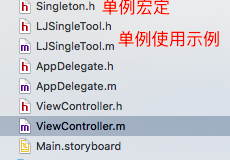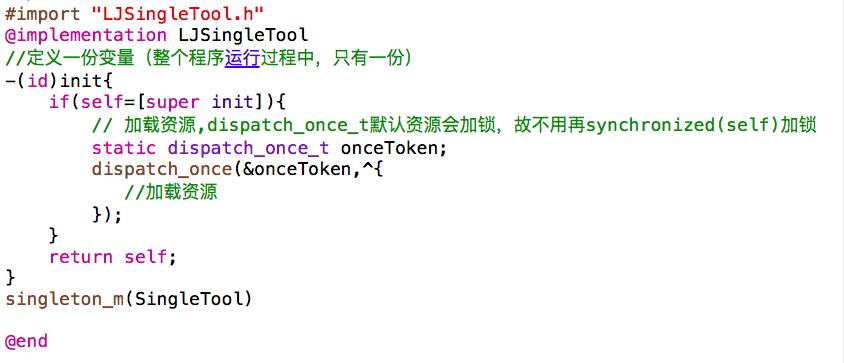完美单例宏定义(兼容ARC和MRC),项目中可以直接使用
单例模式:
1.永远只分配一块内存来创建对象
2.提供一个类方法, 返回内部唯一的一个对象(一个实例)
3.最好保证init方法也只初始化一次
写一个宏定义文件,传入宏定义函数名,自动生成符合类名的单例函数名:

ARC下单例的常规写法(代码中的\是宏定义的写法):
static id _instance; + (id)allocWithZone:(struct _NSZone *)zone { static dispatch_once_t onceToken; dispatch_once(&onceToken, ^{ _instance = [super allocWithZone:zone]; }); return _instance; } + (instancetype)shared##name { static dispatch_once_t onceToken; dispatch_once(&onceToken, ^{ _instance = [[self alloc] init]; }); return _instance; } + (id)copyWithZone:(struct _NSZone *)zone { return _instance; }
MRC写法:
static id _instance; \ + (id)allocWithZone:(struct _NSZone *)zone \ { \ static dispatch_once_t onceToken; \ dispatch_once(&onceToken, ^{ \ _instance = [super allocWithZone:zone]; \ }); \ return _instance; \ } \ \ + (instancetype)shared##name \ { \ static dispatch_once_t onceToken; \ dispatch_once(&onceToken, ^{ \ _instance = [[self alloc] init]; \ }); \ return _instance; \ } \ \ - (oneway void)release \ { \ \ } \ \ - (id)autorelease \ { \ return _instance; \ } \ \ - (id)retain \ { \ return _instance; \ } \ \ - (NSUInteger)retainCount \ { \ return 1; \ } \ \ + (id)copyWithZone:(struct _NSZone *)zone \ { \ return _instance; \ }
宏在单例类中的用法(.h文件):

宏在单例类中的用法(.m文件):

很明显,极大的精简了单例的写法,提高了代码的复用价值。
具体使用效果:

对象的地址打印:

工作中用到单例,每次重写烦不胜烦。理解了单例的作用和写法,不妨试试这个宏定义,也可以提出修改共同进步



